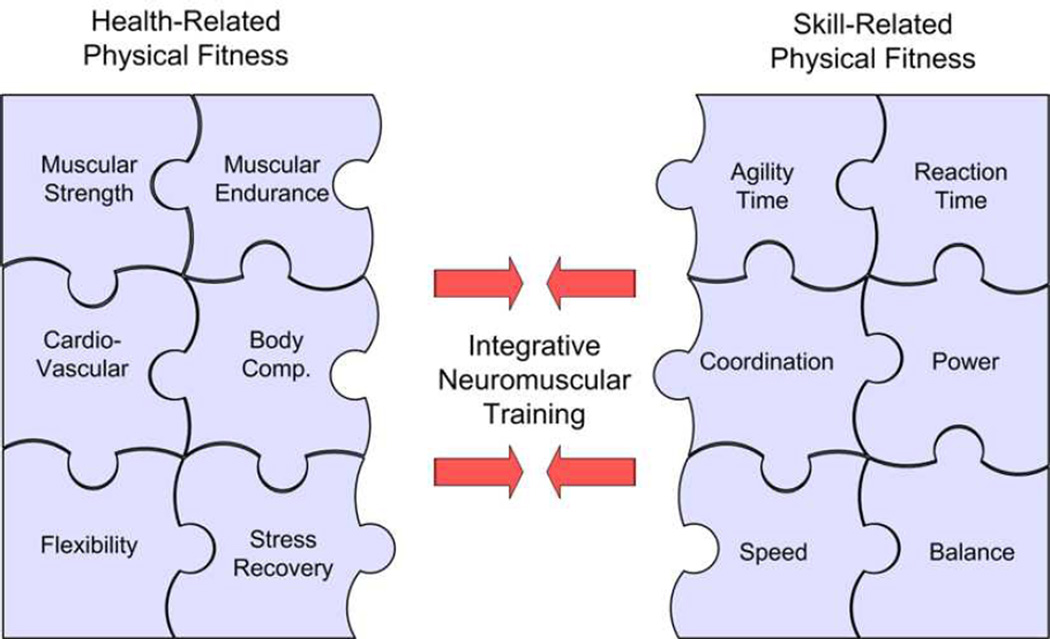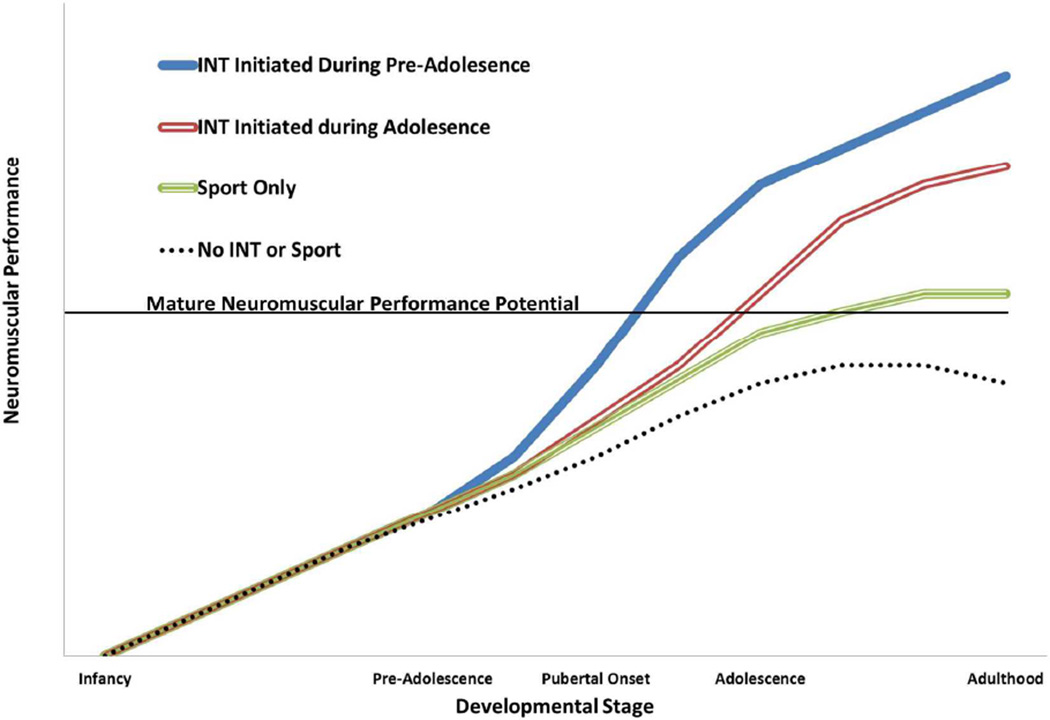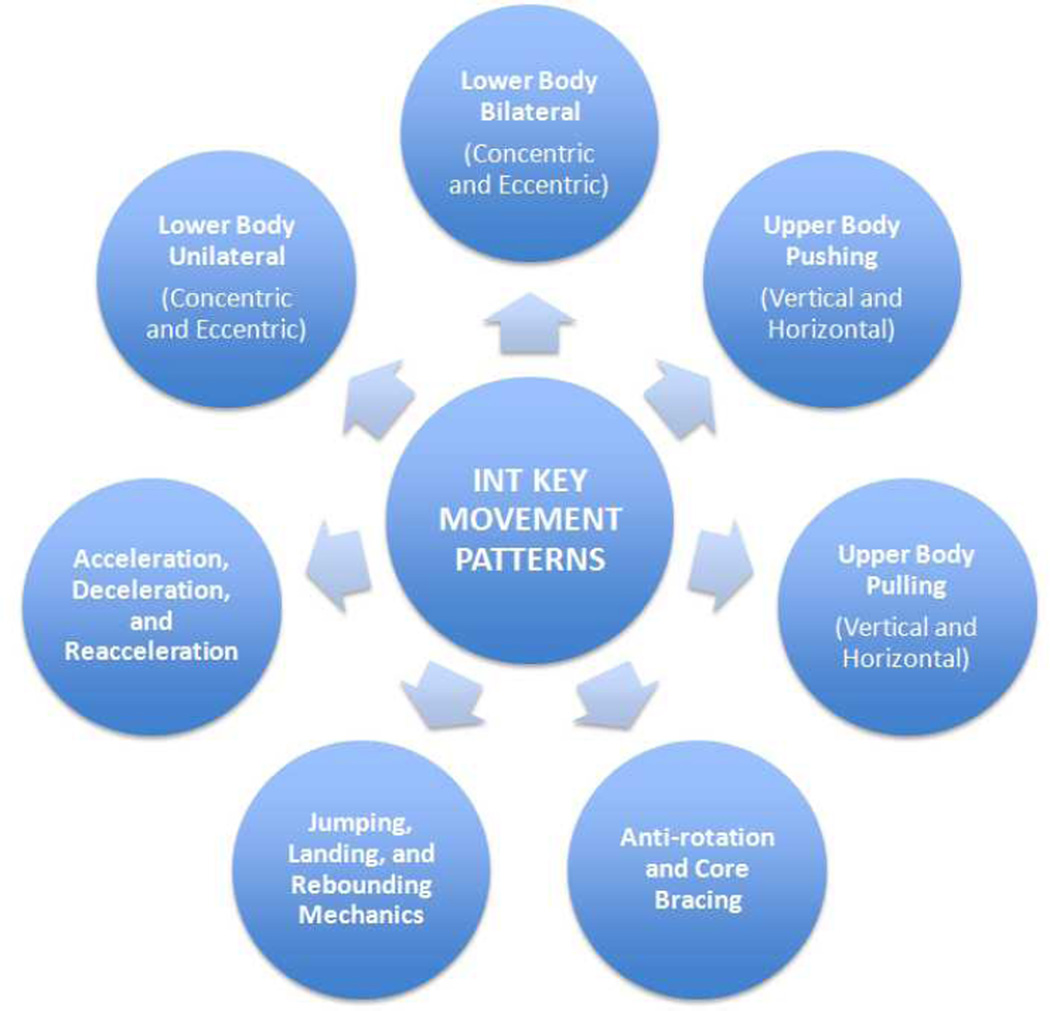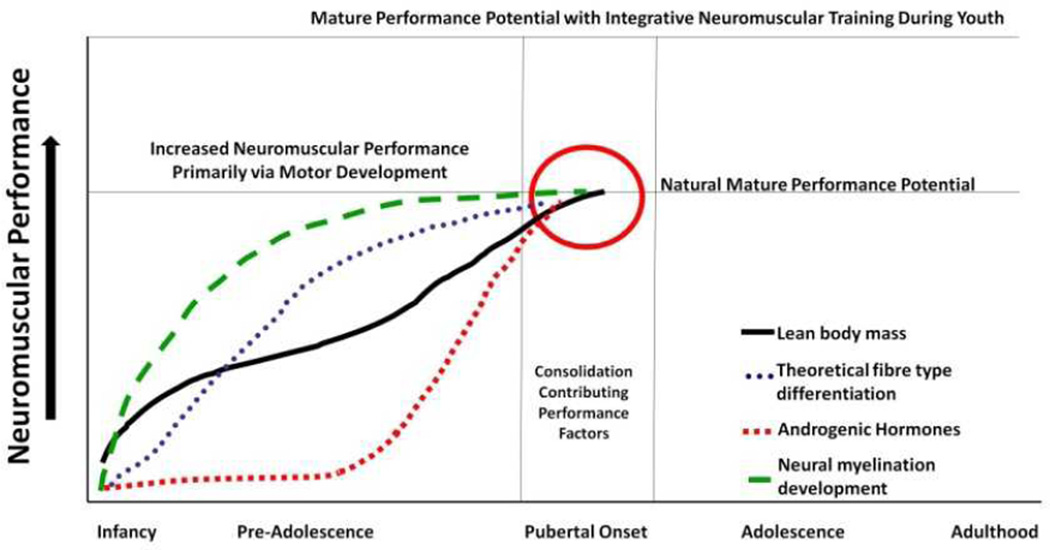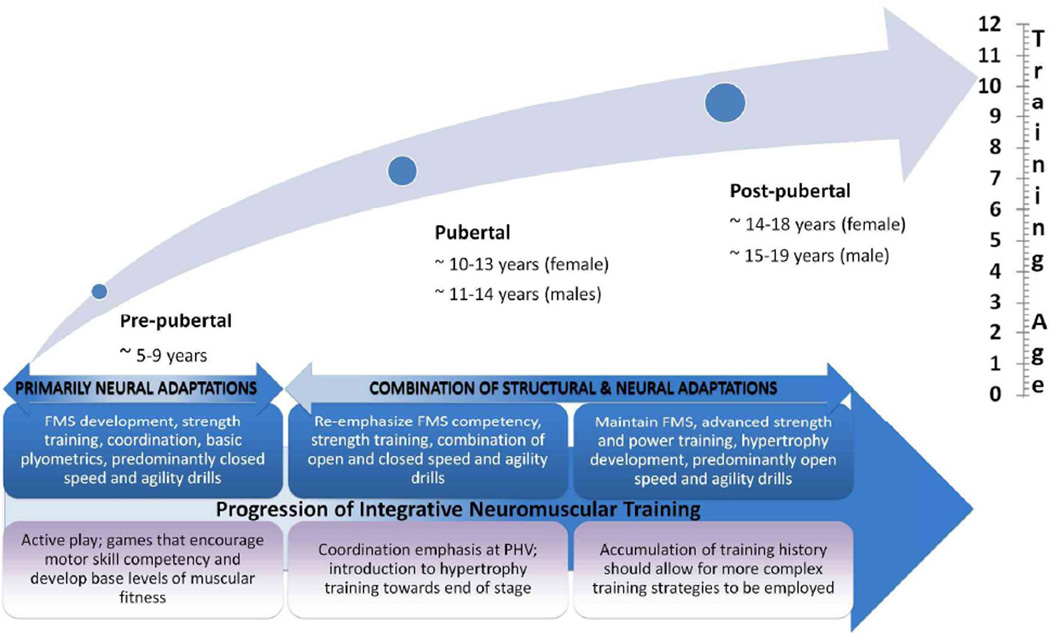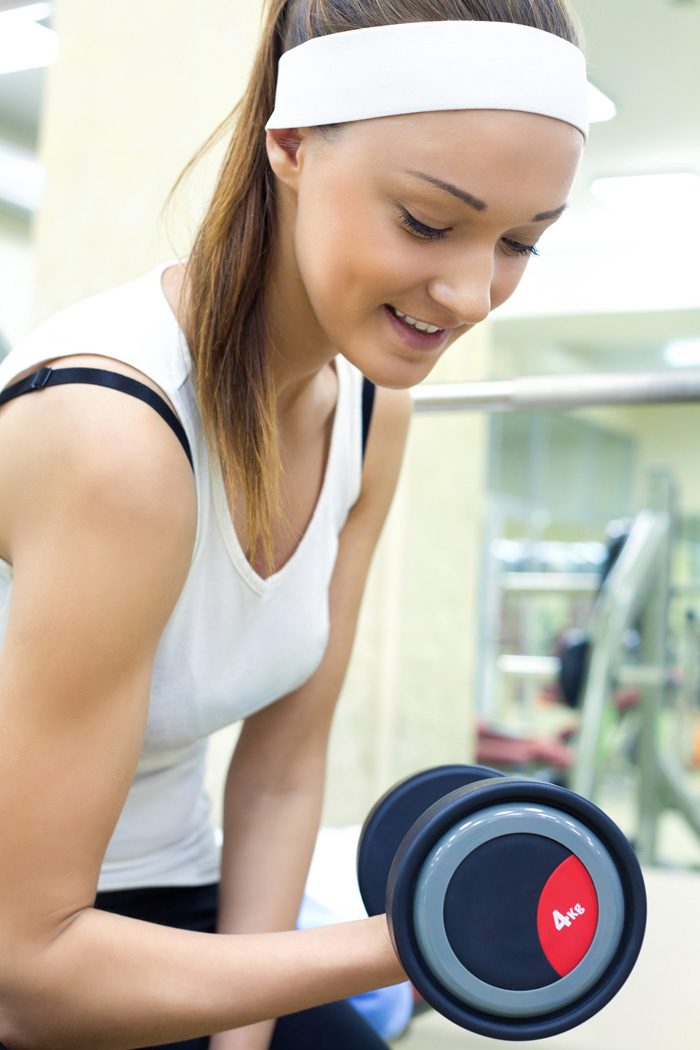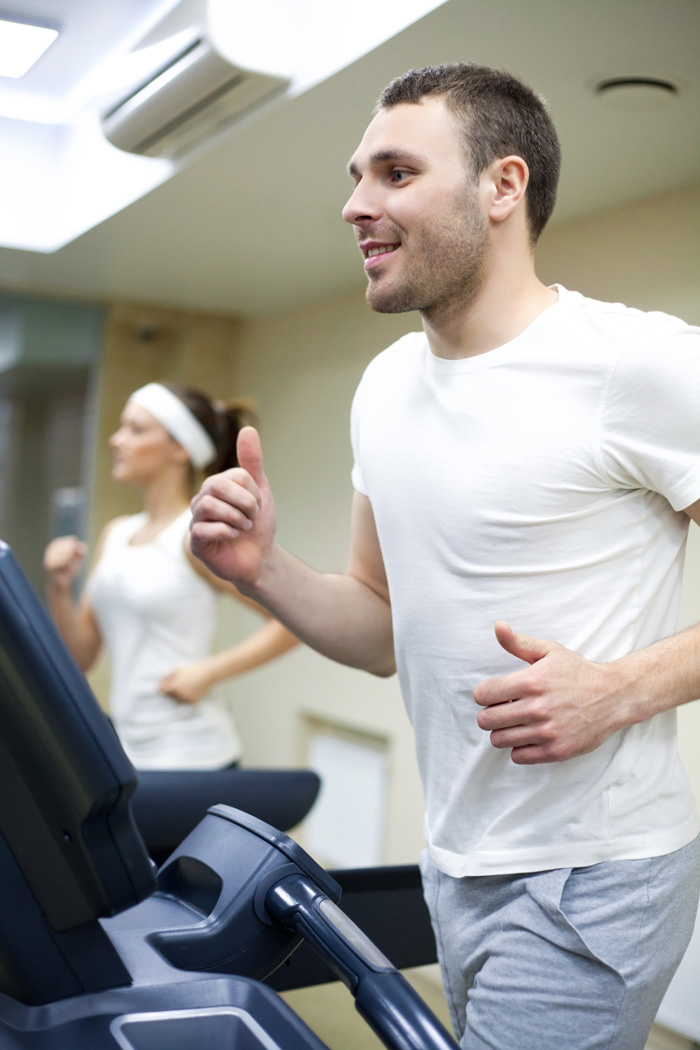INTRODUCTION
Participation in organized youth sports is increasing and the opportunities to participate in more competitive environments is happening at younger ages.(1) The interest from parents and coaches to help youth enhance sports performance has fostered a concomitant growth in youth strength and conditioning, performance enhancement and injury prevention programs in fitness centers and private training facilities. These youth training programs have raised interest and concern from parents, clinicians, coaches and fitness professionals regarding the timing of when it might be safe or optimal to integrate more specialized physical training into youth development programs.(5, 14, 46)Specifically, many parents ask if it is safe for their child to “lift weights” or want to know the “best age” or “when is it safe” for their child to start regular participation in more structured conditioning activities.(41)
This emphasizes the long-enduring interest in the most appropriate and safest time during maturation to start specialized physical training (i.e., strength and conditioning, performance enhancement or injury prevention) with youth. Further questions also arise regarding the determination of the optimal time to initiate and progress programming of physical conditioning for children and adolescents. This review synthesizes the latest literature regarding the initiation and implementation of integrative neuromuscular training for youth. In addition, we discuss the concept of “training age” and examine the critical importance of exposing children to a variety of developmentally appropriate activities early in life in order to reduce the risk of sports-related injuries and improve health- and skill-related measures of physical fitness.
OPERATIONAL DEFINITIONS
For simplicity, the term youth refers to children (Tanner stages 1 and 2 of sexual maturation; approximately up to age 11 years in girls and 13 years in boys) and adolescents (Tanner stages 3 and 4 of sexual maturation; approximately ages 12 to 18 years in girls and 14 to 18 years in boys). The term pre-adolescent refers to boys and girls who have not yet developed secondary sex characteristics. Integrative neuromuscular training (INT) is a conceptual training model that is operationally defined herein as a training program that incorporates general (e.g., fundamental movements) and specific (e.g., exercises prescribed to target motor control deficits) strength and conditioning activities including resistance training, dynamic stability exercises, core focused training, plyometric drills and agility training that are specifically designed to enhance health and skill-related components of physical fitness (Figure 1).(40, 41)
Figure 1.
Integrative training model indicating a focus on the development of fundamental motor skills through activities which consolidate skill- and health-related fitness, may maximize training age during pre-adolescence. Reprinted with permission from “Myer GD, Faigenbaum AD, Ford KR, Best TM, Bergeron MF, Hewett TE. When to initiate integrative neuromuscular training to reduce sports-related injuries and enhance health in youth? Curr Sports Med Rep 2011;10:157-66.”
The cornerstone of INT is age-appropriate education and instruction by qualified professionals who understand the fundamental principles of pediatric exercise science and genuinely appreciate the physical and psychosocial uniqueness of children and adolescents. INT is designed to help youth master fundamental motor skills, improve movement mechanics, and gain confidence in their physical abilities while participating in a program that includes variety, progression and proper recovery intervals.(14, 40)Training age is defined as the amount of time accumulated from both periodic and longitudinal participation in training programs and sport related activities that foster the development of musculoskeletal health, basic movement patterns and overall physical fitness.
THE IMPORTANCE OF TRAINING AGE
The question “How young is too young?” is related to the determination of timing to initiate training for school-age youth. This is particularly important for aspiring young athletes who are often ill-prepared for the physical demands of sports practice and competition. Insufficient readiness for sports practice and competition may be a consequence of the current decline in unstructured physical activity among children and adolescents in the United States and is an antecedent for increased injury risk.(45–47) While many factors can contribute to sports-related injuries in youth (e.g., previous injury, muscle imbalances, nutritional deficiencies, improper footwear), poor physical fitness exacerbated by secular trends of decreased muscular strength and fundamental movement skills (FMS) in youth likely play a primary role.
Deconditioning associated with growth and development can be especially detrimental as injury risk factors may manifest during maturation.(19, 23, 43)In the absence of sufficient corresponding neuromuscular adaptation, musculoskeletal growth during maturation can influence the development of abnormal movement mechanics during certain activities.(20, 23)If not addressed early, these developmentally related injury risk factors may continue through adolescence and into young adulthood, thus predisposing young athletes to increased risk of a variety of musculoskeletal injuries.(24, 42, 45)This troubling trend underscores the importance of encouraging participation in strength-building and skill-enhancing activities in childhood in order to avert declines in motor skill development and neuromuscular fitness during adolescence.(4)
Studies investigating the trainability of youth with resistance and integrative-type training protocols have demonstrated consistent improvements in selected performance measures in children and adolescents following progressive training programs.(9, 13, 15–17, 26, 44, 48, 49, 55, 56, 67)While chronological age has been historically used for initial participation and grouping of sports teams, it is clear that maturity-related differences in body size and motor skill performance emerge around 6–7 years of age.(38)These developmental differences in stature and skill can make programming for youth based on chronological age contentious.
In this light, somatic (body shape related) maturational assessments have been proposed as a method to identify rapid adolescent growth(36) and to help guide program development for youth.(41) Individual determination of the percentage of adult height has also been used as a non-invasive indicator of maturity status.(38). Peak height velocity (PHV) is the maximum growth rate during the adolescent growth spurt, which occurs at approximately age 12 in girls and age 14 in boys.(52, 61) However, youth programs based on either biological or chronological indicators often miss the mark related to the appropriateness of the exercise selection or the design of the fitness program. While it is beneficial to initiate INT programs during pre-adolescence prior to the period of PHV, it is likely that children with earlier somatic maturation (body size growth) may be particularly responsive to INT during the growing years.(40)Regular exposure to this type of training early in life will increase the training age of youth and will likely set the stage for even greater gains in physical fitness during their post-pubertal years; provided that the training program is well-designed and consistent with an individual’s needs, goals and abilities. Currently, there is no evidence that indicates a minimum age for participation in INT programs. However, it is generally agreed that participants must be able to follow coaching instructions and be able to handle the attention demands of a training program. A child that is deemed ready for structured sports participation (about age 7 or 8 years) would typically be ready for INT,(5, 12) although the importance of improving motor skills during the preschool years should not be overlooked.(21, 39)
INCREASING TRAINING AGE IN YOUTH
In the context of this discussion, training age relates to the length of time from initiation of regular fitness training or INT until the present time. For example, youth who begin INT at an earlier age will have a greater training age relative to their chronological age when compared to their peers who start training later. It should also be noted that youth who initiate improper or inconsistent training may not progress in training age or reap the desired benefits (Figure 2). Of note, fitness professionals working with youth should consider the importance of planned rest and recovery within training periods as well as periods for teaching proper technique that can facilitate rest and recovery and optimize long-term training adaptations.
Figure 2.
Conceptual model which compares the effects of integrative neuromuscular training initiated at different times in youth. The different colored lines represent the initiation of these integrative training techniques during pre-adolescence (Blue) and adolescence (Red) which will likely improve motor capacity and performance beyond natural adult potential (without such training). It is suggested that integrative neuromuscular training initiated in pre-adolescence and maintained into adolescence will maximize training age and the potential to achieve optimal adulthood motor capacity. Broken lines indicate potential detrimental effects of physically inactive youth who are not exposed to integrative training model.
Practically, training age can provide a theoretical construct which should guide the practitioner in selecting appropriate exercise criteria. While INT programming is beneficial to children whose motor capabilities are highly “pliable” and amenable to age-appropriate interventions, youth who are not exposed to environments that enhance motor skill development are susceptible to a regression of their training age.(11) As such, lapses in training due to extended periods of injury, school vacations, or sedentary lifestyle may either set the young athlete back in training age, or in extreme cases, regress the training age back to near zero. Because of this, it is important for fitness professionals who work with youth to understand the complete “sport and training related-history” of each participant which should include information on participation in sports and in strength and conditioning activities to gain a perspective to the overall training volume.
Training age is also relevant within the context of the chosen activity. Consider the case of two 12 year old girls who are interested in trying out for a soccer team for the first time. If the first child consistently participated in daily physical education, outdoor free play activities and after-school gymnastics lessons during early childhood (∼ age 7–8 years), she would have a different training age and subsequent level of general physical preparation than the second child who played two years of basketball at age 8 and 9 and remained sedentary for several years thereafter. In this same light, is there difference between a “good” training age and a “bad” training age. That is, a child who has participated in unsupervised “training” for 2 years, is not necessarily better equipped than a child who has participated in age-appropriate, progressive and supervised training for 12 months.
Because of the differing demands of available sport choices, it is recommended that aspiring young athletes engage in a variety of sports and physical activities to improve motor skill performance, enhance joint mobility and stability, and increase strength and power while gaining confidence in their abilities to be physically active and play sport. An important consideration in regards to the health and wellbeing of young athletes is to provide exposure to various activities whereby generic pattern recognition, hand-eye coordination, and decision-making skills can be tested and developed.(3) This has important implications for youth as early specialization has previously been linked to increased injury risk in young athletes.(10) Research suggests that a cumulative exposure to a breadth of sporting experiences may indeed result in selective transfer of pattern recall skills and facilitation of expert performance.(2)
Since the relative magnitude of forces from well-designed and INT programs are typically less than those from sport activities, there is little evidence to suggest that safety would be a limiting factor for the initiation of supervised INT with children. In many cases, children are able to learn basic movement patterns such as squatting, pushing, pulling, hip hinging, core bracing, hopping and jumping, and progress to more complex movements over time. The limiting factor is not their chronological or biological age, but rather the amount of time that they have been practicing these basic movements while gaining competence and confidence in their abilities to move. That is, their training age is an important factor which influences their ability to perform simple and complex movement patterns with energy, vigor and confidence. The importance of increasing a child’s training age cannot be underestimated because it truly sets the stage for further physical development in later adolescence.(31) Conversely, adolescents who do not develop training age in younger years will have more difficulty mastering FMS in their post-pubertal and teenage years.
The following section will discuss the physical changes that school-age youth undergo that make them ideally suited to enhance their FMS and general preparedness for sport. If young athletes begin to develop efficient movement patterns and continue to improve their muscle strength before adolescence, they will be better prepared for more advanced training and skill mastery due to their advanced training age (FIGURE 2). Conversely, adolescents who have not been exposed to environments that enrich their motor skill development early in life will be ill-prepared for advanced training due to their limited training experience and, consequently, will need to initiate INT with basic skills and exercises.
While it is beyond the scope of the current report to outline the multiple variations of training exercises and protocols for various training ages, it should be noted that key INT movement patterns highlighted in figure 4 will be included for youth of all training ages.(12, 30) However, relative to training age, there would be a difference in terms of overall focus on development of the skill within a training session. For example, for an adolescent with a training age of 0, the training session could include70% FMS and 30% resistance training. Conversely for an adolescent with a training age of 8+, these relative percentages of training focus could be reversed. Training that focuses on FMS is not only used with the younger training ages, but there is a need for greater emphasis on developing basic skills in youth with less training experience. Fitness professionals must be sensitive to inter-individual differences in physical development and fitness abilities between youth of the same age, and training programs should be consistent with the needs, interests and abilities of each participant.
Figure 4.
The key movements patterns which should be the cornerstone and focus of integrative neuromuscular training protocols.
Differential Programming for Youth Based on Training Age
If a child has engaged in appropriate training relative to their chosen activity, before and during maturation, they will be poised to capitalize on the many combinatory and consolidating factors that support motor skill performance during their post-pubertal training years.(FIGURE 3)The post-pubertal phase of development offers a unique opportunity for adolescents to benefit from significant neuromuscular adaptations, driven primarily via increases in testosterone, growth hormone and insulin-like growth factor (37). Irrespective of the rate of maturation (i.e. early, normal, or late), the alterations in hormonal profile associated with this stage of development will at some point lead to rapid developments in the musculoskeletal system. In addition to continued neural adaptation, the post-pubertal phase will also induce alterations to muscle cross-sectional area (62), fiber pennation(6) and stiffness (28). There will also be natural adaptation to tendons, with research indicating that size (27), elasticity (29) and stiffness (66) increase throughout a child’s development. Additionally, adolescents will typically experience further increases in bone mineral density during this period.(64)Collectively, these adaptations lead to rapid gains in overall body mass, with the greatest rate of change termed peak weight velocity (PWV), which occurs approximately 12 months after the growth spurt(Figure 3)(8).
Figure 3.
In youth there are several factors which contribute to motor control and strength expression. In children, motor control and strength may be less related to hypertrophy and more likely associated with neural development. It is proposed that integrative neuromuscular training focused on skill-related fitness (e.g. Agility, reaction time, coordination, power, speed and balance) can maximize neural development during pre-adolescence and optimally prepare youth to capitalize on the consolidated factors which contribute to motor performance following the onset of puberty. Figure reproduced from “Kraemer WJ, Fry AC, Frykman PN, Conroy B, Hoffman J. Resistance Training and Youth. Pediatric Exercise Science 1989;1:336-50” and reprinted with permission from “Myer GD, Faigenbaum AD, Ford KR, Best TM, Bergeron MF, Hewett TE. When to initiate integrative neuromuscular training to reduce sports-related injuries and enhance health in youth? Curr Sports Med Rep 2011;10:157-66.”
It is imperative that at the post-pubertal stage of development, adolescents continue to participate in structured INT programs to reduce injury risk,(7, 44, 59, 65) enhance performance,(44) and increase the likelihood of long-term physical activity adherence.(60) INT programs are necessary to help reduce ACL injury risk in post-pubertal females, as they learn to perform with increased body mass and, of significance, a heightened knee valgus ‘collapse’ mechanism.(43) Specifically, post-pubertal INT programs should primarily focus on FMS maintenance to ensure that motor coordination patterns learned during the pre-pubertal and pubertal phases have not been negatively affected as a result of the growth spurt. However, muscular strength is central to the successful execution of FMS. Resistance training should be the cornerstone of the INT program in order to build on existing strength levels and to take advantage of the increased hypertrophic environment within the muscle associated with the post-pubertal stage of development.(31, 33)
During the post-pubertal stage, it should be noted that the adolescent youth may also experience significant psychosocial changes, which may negatively affect their exercise adherence, such as motivation, self-perception, and confidence. For example, it has previously been stated that between 13 and 18 years of age, adolescents transition from a reliance on externally-sourced feedback, to greater use of self-referenced judgment of ability.(25)Therefore, when working with post-pubertal youth, it is essential that all training sessions attempt to foster a task-mastery motivational climate, encourage self-determined motivation, provide an adequate level of challenge, and enhance confidence.(51, 54, 58) Such an approach will differ from those used when working with younger populations. Understanding these factors is important, as they have previously been associated with drop out in youth sport.(18) The use of social support systems,(50) age-appropriate mental skills training,(22) and ensuring that adolescents maintain a sense of peer friendship (57)are strategies that the pediatric exercise specialist can implement to maximize enjoyment and help promote long-term participation in physical activity.
NO PRIOR ENGAGEMENT IN INT DURING PRE-PUBERTAL AND PUBERTAL PHASES (Training Age: 0)
It should be noted that the INT prescription should not be age-determined, but rather age-related and based primarily on the training age of the young athlete. More specifically, INT should be based on training experience, biological status, motor skill competency, psychosocial maturity and existing strength levels.(30, 31, 33) Therefore, irrespective of chronological age, for post-pubertal youth who have not participated in earlier INT programs, initial focus should be directed towards developing appropriate FMS in addition to developing base levels of muscular strength (Figure 4). It should be noted that initiation of INT emphasizes each of the primary movements to be instituted for an adolescent with training age of 0 (Table 1). While fundamental movements are consistent across training age and independent of chronological age, youth who participate in INT based programming early in life may be more equipped for the advanced programming indicated with increased training age.(40, 41)
Table 1.
Example whole-body session for an adolescent with a training age of 0 years
| Session Phase | Exercise | INT Key Movement Pattern | Volume (sets x reps) |
Intensity (%1RM) |
Rest (minu tes) |
|---|---|---|---|---|---|
|
Warm-up (FMS) |
Foam roller complex | Whole body myofascial release therapy | 2 × 10 (each site) | N/A | 1 |
| KB squat with deficit | Thoracic extension and hip mobilization | 2 × 8 | BW | 1 | |
| Split squats | Lower body unilateral (and gluteal activation) | 2 × 6 (each leg) | BW | 1 | |
| Low box jump | Jumping, landing and rebounding mechanics | 2 × 6 | BW | 1 | |
| Scapula push ups | Scapula retraction | 2 × 8 | BW | 1 | |
| Monster band push press | Upper body pushing (vertical) | 2 × 8 | Light band | 1 | |
| Monster band pull downs | Upper body pulling (vertical) | 2 × 8 | Light band | 1 | |
| Plank variations | Anti-rotation and core bracing | 2 × 30 seconds | BW | 1 | |
|
Main (Resistance) |
OH squat | Lower body bilateral | 3 × 6 | Wooden dowel or junior barbell |
2 |
| Elevated press-ups | Upper body pushing (horizontal) | 3 × 8 | BW | 2 | |
| TRX supine pull ups | Upper body pulling (horizontal) | 3 × 8 | BW | 2 | |
|
Auxiliary Exercises |
Stretching complex | N/A | 2 × 20 seconds | N/A | 1 |
Sedentary lifestyles and a failure to participate in INT programs prior to and around the onset of puberty will typically lead to poor posture, poor movement mechanics, and insufficient levels of muscular strength that do not reach expected adult potential(Figure 2). The lack of motor skill development associated with children who are not exposed to either INT or sport participation can foster reduced motor skill development relative to youth of past., Sedentary youth who have a low training age will initially need to focus on FMS development that incorporates basic forms of locomotion, manipulation, and stabilization.(35)Additionally, a well-designed INT program should also enhance muscular strength expression within other key movement patterns (Figure 4). Having the ability to safely express muscular force within the spectrum of movement competencies proposed in Figure 4 will provide the best opportunity for a child or adolescent to safely and effectively participate in a range of physical activities, and allow them to tolerate the unpredictable impact forces commonly experienced in high-action, sport activities. For those individuals who wish to participate in organized, competitive sport, appropriate physical conditioning which includes muscle strengthening and FMS development will help reduce the potential for athletic injuries(63) and form the foundation for more advanced complex training modes such as weightlifting (31, 33) and advanced plyometrics.(32)
PRIOR ENGAGEMENT IN INT DURING PRE-PUBERTAL AND PUBERTAL PHASES (Training Age: 8+)
On the proviso that children participate in INT programs prior to and during puberty, the post-pubertal phase offers a unique opportunity to build on existing levels of health- and skill-related fitness. Owing to the earlier mastery of FMS and development of base levels of muscular strength, these individuals can be exposed to more intensive bouts of physical activity with the knowledge that the inherent movement patterns are sufficiently robust to tolerate greater internal and external loads. However, a stipulation to this philosophy is that FMS should routinely be revisited irrespective of training history to avoid the manifestation of technical deficiencies over time.(31, 33). For example, it has been suggested that when prescribing agility training sessions, qualified physical education teachers and youth coaches should initially prioritize FMS development and predominantly pre-planned agility tasks during pre-puberty.(31, 33) As the child enters puberty, the training emphasis should shift to a greater use of reactive agility drills, whilst also maintaining FMS competency, albeit for a smaller amount of time within a training session (Table 2 and 3).
Table 2.
Example lower body session for an adolescent with a training age of 8+ years
| Session Phase | Exercise | INT Key Movement Pattern | Volume (sets x reps) |
Intensity (%1RM) |
Rest (minutes) |
|---|---|---|---|---|---|
|
Warm-up (FMS) |
Foam roller complex | Lower body myofascial release therapy | 2 × 10 (each site) | N/A | 1 |
| Mini-band walks | Gluteal activation | 2 × 10 (each leg) | N/A | 1 | |
| Clam shells | Gluteal activation | 2 × 8 (each leg) | N/A | 1 | |
| Drop jumps (30 cm) | Jumping, landing, rebounding mechanics | 3 × 3 | BW | 1–2 | |
|
Main (Resistance) |
Power clean | Lower body bilateral (CON) | 3 × 4 | 80 | 2–3 |
| Back squat | Lower body bilateral (ECC/CON) | 4 × 5 | 85 | 2–3 | |
| Lunge | Lower body unilateral | 3 × 6 (each leg) | 85 | 2–3 | |
|
Auxiliary Exercises |
Romanian deadlift | Lower body bilateral (ECC) | 3 × 5 | 85 | 2–3 |
Table 3.
Example upper body session for an adolescent with a training age of 8+ years
| Session Phase | Exercise | INT Key Movement Pattern | Volume (sets x reps) |
Intensity (%1RM) |
Rest (seconds) |
|---|---|---|---|---|---|
|
Warm-up (FMS) |
Foam roller complex | Upper body myofascial release therapy | 2 × 10 (each site) | N/A | 1 |
| Y, T, W, L’s | Scapula retraction | 5 × 1 | N/A | 1 | |
| Sitting t-spine rotations | Thoracic spine mobilization | 3 × 4 (each side) | N/A | 1 | |
|
Main (Resistance) |
Bench pull | Upper body pulling (horizontal) | 4 × 5 | 85 | 2–3 |
| DB Bench press | Upper body pushing (horizontal) | 4 × 5 | 85 | 2–3 | |
| WG Pull ups | Upper body pulling (vertical) | 3 × 6 | 80 | 2–3 | |
| Snatch press | Upper body pushing (vertical) | 3 × 6 | 80 | 2–3 | |
|
Auxiliary Exercises |
SA Bar rotations | Anti-rotation and core bracing | 3 × 6 (each side) | 80 | 2–3 |
Appropriately prescribed training in addition to the acute hormonal changes experienced during this phase of development will enable individuals to realize greater adaptations (both neural and architectural) to the neuromuscular system (FIGURES 3 and 5). Collectively, these changes will enable post-pubertal youths to generate greater overall force which will consequently enhance the performance of motor skills such as sprinting (53) and jumping.(34) In addition to traditional resistance training exercises (squatting, deadlifting, pressing and pulling), weightlifting movements (clean and jerk, snatch and their derivatives) and advanced plyometrics serve as safe and effective training methods for post-pubertal youth in order to develop muscular strength and power. However, it is essential that those responsible for instructing weightlifting movements and advanced plyometrics to school-age youth possess sufficient practical experience teaching these exercises to children and adolescents, a recognized professional certification, and a level of knowledge commensurate with a college degree in exercise science or physical education. While less experienced fitness professionals can assist in the organization of youth programs, it is unlikely they will be able to provide the level of instruction that is needed for more advanced INT which may include weightlifting movements and more complex plyometric drills.
Figure 5.
Graphical representation of the theoretical potential to increase training age by starting early in youth. Note that the recommended content is provided for each stage of maturation, however, as with any long-term development, there must be flexibility to ensure that programming is commensurate with the individual’s training age.
CONCLUSION
The cornerstone of INT is training age-appropriate education and instruction by qualified professionals who understand the principles of pediatric exercise science and the concept of training age. The initiation of INT early in youth can help increase training age that is vital for children and adolescents whose motor capabilities are highly “plastic” and responsive to training. Research demonstrates that significant, amenable benefits can be gained from training age appropriate interventions. While an in-depth analysis of key training variables involved in successful youth INT programs is outside the scope of the current manuscript, readers are directed to recent position statements from leading health and fitness organizations.(12, 30). Due to the growing interest in youth fitness and pediatric exercise, qualified fitness professionals are in an inimitable position to help children master FMS, improve movement mechanics, and gain confidence in their abilities to be physically active.
Figure 6.
Figure 7.
Figure 8.
Learning Objectives.
To introduce an integrative neuromuscular training model that can be used to enhance the health, fitness, and wellness of all children and adolescents.
To understand the potential benefits associated with strength and conditioning programs implemented with youth to reduce injury risk and enhance motor skill development that will support a physically active lifestyle.
To comprehend the concept of “training age” and the implications associated with systematic training beginning during early childhood.
Condensed Version & Bottom Line.
Recent trends indicate that widespread participation in organized youth sports is occurring at younger ages. With the increased involvement in competitive youth sport activities, there is growing interest from parents, clinicians, coaches and teachers regarding the optimal age to encourage and integrate more specialized physical training into youth physical development programs. This review synthesizes the latest literature regarding the design and implementation of integrative neuromuscular training for school-age youth. In addition, the concept of “training age” and its associated reductions in sports-related injury risk and improvements in motor skill development will be discussed to support participation in a variety of physical activities as an ongoing lifestyle choice.
Summary Statement.
As more children and adolescents participate in organized sports and physical conditioning activities in schools, fitness centers and private clubs, it is important to establish age-appropriate training guidelines for the safe and effective initiation of integrative training activities that are purposely designed to enhance neuromuscular function, increase muscular strength and improve a child’s capacity to participate regularly in sports and recreational activities.
Acknowledgments
The authors would like to acknowledge funding support from National Institutes of Health Grant R01 AR055563-01A1.
Biographies

Gregory D. Myer, Ph.D., CSCS*D, FACSM, is Director of Research and the Human Performance Laboratory in the Division of Sports Medicine at Cincinnati Children’s Hospital Medical Center and holds primary academic appointments in the Departments of Pediatrics and Orthopaedic Surgery within the College of Medicine at the University of Cincinnati.
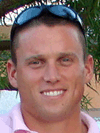
Rhodri Lloyd, Ph.D., CSCS*D, ASCC is a lecturer in Physiology and Health at Cardiff Metropolitan University, United Kingdom, and is paediatric lead for the UK Strength and Conditioning Association
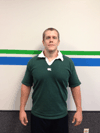
Jensen Brent, CSCS, is the Owner and Director of Training at The Academy of Sports Performance in Cincinnati, OH and Head Strength and Conditioning Coach for the Cincinnati Kelts Rugby Football Club.

Avery Faigenbaum, Ed.D., CSCS, FACSM, is a full professor in the Department of Health and Exercise Science at The College of New Jersey, where his research focuses on the role that resistance exercise plays in the health and fitness of children and adolescents.
Footnotes
Publisher's Disclaimer: This is a PDF file of an unedited manuscript that has been accepted for publication. As a service to our customers we are providing this early version of the manuscript. The manuscript will undergo copyediting, typesetting, and review of the resulting proof before it is published in its final citable form. Please note that during the production process errors may be discovered which could affect the content, and all legal disclaimers that apply to the journal pertain.
The authors declare no conflicts of interest.
REFERENCES
- 1.NCYS report on trends and participation in organized youth sports. Book NCYS report on trends and participation in organized youth sports. National Council on Youth Sports Web site; 2008. Editor (Ed.) City. [Google Scholar]
- 2.Abernethy B, Baker J, Côté J. Transfer of pattern recall skills may contribute to the development of sport expertise. Appl Cognit Psychol. 2005;19:705–718. [Google Scholar]
- 3.Baker J, Côté J, Abernethy B. Sport-specific practice and the development of expert decision-making in team ball sports. J. Appl. Psychol. 2003;15:12–25. 15:12-25, 2003. [Google Scholar]
- 4.Basterfield L, Adamson AJ, Frary JK, Parkinson KN, Pearce MS, Reilly JJ. Longitudinal Study of Physical Activity and Sedentary Behavior in Children. Pediatrics. 2011;127:e24–e30. doi: 10.1542/peds.2010-1935. [DOI] [PubMed] [Google Scholar]
- 5.Behm DG, Faigenbaum AD, Falk B, Klentrou P. Canadian Society for Exercise Physiology position paper: resistance training in children and adolescents. Appl. Physiol. Nutr. Metab. 2008;33:547–561. doi: 10.1139/H08-020. [DOI] [PubMed] [Google Scholar]
- 6.Blimkie CJ, Gisolf C, Lamb D. Age- and sex-associated variation in strength during childhood: Anthropometric, morphologic, neurological, biomechanical, endocrinologic, genetic and physical activity correlates. Perspectives in Exercise Science and Sports Medicine Vol. 2. Youth Exercise and Sport. 1989:99–163. [Google Scholar]
- 7.Caine D, Maffulli N, Caine C. Epidemiology of injury in child and adolescent sports: injury rates, risk factors, and prevention. Clin. Sports Med. 2008;27:19–50. doi: 10.1016/j.csm.2007.10.008. vii. [DOI] [PubMed] [Google Scholar]
- 8.de Ste Croix M. Advances in paediatric strength assessment: changing our perspective on strength development. Journal of Sports Science and Medicine. 2007;6:292–304. [PMC free article] [PubMed] [Google Scholar]
- 9.DiStefano LJ, Padua DA, Blackburn JT, Garrett WE, Guskiewicz KM, Marshall SW. Integrated injury prevention program improves balance and vertical jump height in children. J Strength Cond Res. 2010;24:332–342. doi: 10.1519/JSC.0b013e3181cc2225. [DOI] [PubMed] [Google Scholar]
- 10.Education NAfSaP. Position Statement: guidelines for participation in youth sport programs: specialization versus multiple-sport participation. American Alliance for Health, Physical Education, Recreation and Dance. 2010 [Google Scholar]
- 11.Faigenbaum AD, Farrel A, Fabiano M, Radler T, Naclerio F, Ratamess NA, Kang J, Myer GD. Effects of Detraining following Integrative Neuromuscular Training on Fitness Performance in Children. Journal of Strength and Conditioning Research. 2013 In Press. [Google Scholar]
- 12.Faigenbaum AD, Kraemer WJ, Blimkie CJ, Jeffreys I, Micheli LJ, Nitka M, Rowland TW. Youth resistance training: updated position statement paper from the national strength and conditioning association. J Strength Cond Res. 2009;23:S60–S79. doi: 10.1519/JSC.0b013e31819df407. [DOI] [PubMed] [Google Scholar]
- 13.Faigenbaum AD, Loud RL, O'Connell J, Glover S, Westcott WL. Effects of different resistance training protocols on upper-body strength and endurance development in children. J Strength Cond Res. 2001;15:459–465. [PubMed] [Google Scholar]
- 14.Faigenbaum AD, Myer GD. Pediatric resistance training: benefits, concerns, and program design considerations. Curr. Sports Med. Rep. 2010;9:161–168. doi: 10.1249/JSR.0b013e3181de1214. [DOI] [PubMed] [Google Scholar]
- 15.Faigenbaum AD, Westcott WL, Micheli LJ, Outerbridge AR, Long CJ, LaRosa-Loud R, Zaichkowsky LD. The Effects of Strength Training and Detraining on Children. J Strength Cond Res. 1996;10:109–114. [Google Scholar]
- 16.Faigenbaum AD, Zaichkowsky LD, Westcott WL, Micheli LJ, Fehlandt AF. The Effects of a Twice-a-Week Strength Training Program on Children. Pediatric Exercise Science. 1993;5:339–345. [Google Scholar]
- 17.Falk B, Mor G. The Effects of Resistance and Martial Arts Training in 6 to 8 Year Old Boys. Pediatric Exercise Science. 1996;8:48–56. [Google Scholar]
- 18.Ferrer-Caja E, Weiss MR. Predictors of intrinsic motivation among adolescent students in physical education. Res. Q. Exerc. Sport. 2000;71:267–279. doi: 10.1080/02701367.2000.10608907. [DOI] [PubMed] [Google Scholar]
- 19.Ford KR, Myer GD, Hewett TE. Longitudinal effects of maturation on lower extremity joint stiffness in adolescent athletes. Am. J. Sports Med. 2010;38:1829–1837. doi: 10.1177/0363546510367425. [DOI] [PMC free article] [PubMed] [Google Scholar]
- 20.Ford KR, Shapiro R, Myer GD, AJ VDB, Hewett TE. Longitudinal Sex Differences during Landing in Knee Abduction in Young Athletes. Med Sci Sports Exerc. 2010;42:1923–1931. doi: 10.1249/MSS.0b013e3181dc99b1. [DOI] [PMC free article] [PubMed] [Google Scholar]
- 21.Goldfield GS, Harvey A, Grattan K, Adamo KB. Physical activity promotion in the preschool years: a critical period to intervene. Int. J. Environ. Res. Public. Health. 2012;9:1326–1342. doi: 10.3390/ijerph9041326. [DOI] [PMC free article] [PubMed] [Google Scholar]
- 22.Gucciardi DF, Gordon S, Dimmock JA. Evaluation of a Mental Toughness Training Program for Youth-Aged Australian Footballers: I. A Quantitative Analysis. Journal of Applied Sport Psychology. 2009:307–323. [Google Scholar]
- 23.Hewett TE, Myer GD, Ford KR. Decrease in neuromuscular control about the knee with maturation in female athletes. J. Bone Joint Surg. Am. 2004;86-A:1601–1608. doi: 10.2106/00004623-200408000-00001. [DOI] [PubMed] [Google Scholar]
- 24.Hewett TE, Myer GD, Ford KR, Heidt RS, Jr, Colosimo AJ, McLean SG, van den Bogert AJ, Paterno MV, Succop P. Biomechanical Measures of Neuromuscular Control and Valgus Loading of the Knee Predict Anterior Cruciate Ligament Injury Risk in Female Athletes: A Prospective Study. Am. J. Sports Med. 2005;33:492–501. doi: 10.1177/0363546504269591. [DOI] [PubMed] [Google Scholar]
- 25.Horn T, Harris A. Perceived Competence in Young Athletes: Research Findings and recommendations for Coaches and Parents. In: Smoll FL, Smith RE, editors. Children and Youth in Sport: A Biopsychosocial Perspective. 1996. pp. 309–329. [Google Scholar]
- 26.Jones RA, Riethmuller A, Hesketh K, Trezise J, Batterham M, Okely AD. Promoting fundamental movement skill development and physical activity in early childhood settings: a cluster randomized controlled trial. Pediatr Exerc Sci. 2011;23:600–615. doi: 10.1123/pes.23.4.600. [DOI] [PubMed] [Google Scholar]
- 27.Koivunen-Niemela T, Parkkola K. Anatomy of the Achilles tendon (tendo calcaneus) with respect to tendon thickness measurements. Surg. Radiol. Anat. 1995;17:263–268. doi: 10.1007/BF01795061. [DOI] [PubMed] [Google Scholar]
- 28.Korff T, Horne SL, Cullen SJ, Blazevich AJ. Development of lower limb stiffness and its contribution to maximum vertical jumping power during adolescence. J. Exp. Biol. 2009;212:3737–3742. doi: 10.1242/jeb.033191. [DOI] [PubMed] [Google Scholar]
- 29.Kubo K, Kanehisa H, Kawakami Y, Fukanaga T. Growth changes in the elastic properties of human tendon structures. Int. J. Sports Med. 2001;22:138–143. doi: 10.1055/s-2001-11337. [DOI] [PubMed] [Google Scholar]
- 30.Lloyd RS, Faigenbaum AD, Myer GD, Stone MH, Oliver JL, Jefferys I, Moody J, Brewer C, Pierce KC. United Kingdom Strength and Conditioning Association (UKSCA) Position Statement on Youth Resistance Training. Professional Strength and Conditioning Journal. 2013 In Press. [Google Scholar]
- 31.Lloyd RS, Oliver JL. The Youth Physical Development model: a new approach to long-term athletic development. Strength and Conditioning Journal. 2012;34:37–43. [Google Scholar]
- 32.Lloyd RS, Oliver JL, Meyers RW. The natural development and tranability of plyometric ability during childhood. Journal of Strength and Conditioning Research. 2011;33:23–32. [Google Scholar]
- 33.Lloyd RS, Oliver JL, Meyers RW, Moody J, Stone MH. Long-term athletic development and its application to youth weightlifting. Strength and Conditioning Journal. 2012;34:55–66. [Google Scholar]
- 34.Lloyd RS, Oliver JL, Meyers RW, Read P, Jeffreys I, Nuimphius S. Considerations for the development of agility during childhood and Adolescence. Strength and Conditioning Journal. 2012 In Press. [Google Scholar]
- 35.Lubans DR, Morgan PJ, Cliff DP, Barnett LM, Okely AD. Fundamental movement skills in children and adolescents: review of associated health benefits. Sports Med. 2010;40:1019–1035. doi: 10.2165/11536850-000000000-00000. [DOI] [PubMed] [Google Scholar]
- 36.Malina RM, Bouchard C. Timing and sequence of changes in growth, maturation, and performance during adolescence. In: Bouchard Ma., editor. Growth, maturation, and physical activity. Champaign, Il: Human Kinetics; 1991. pp. 267–272. [Google Scholar]
- 37.Malina RM, Bouchard C, Bar-Or O. Growth, Maturation, and Physical Activity. Champaign, IL: Human Kinetics; 2004. Timing and Sequence of Changes During Adolescence; pp. 307–333. [Google Scholar]
- 38.Malina RM, Cumming SP, Morano PJ, Barron M, Miller SJ. Maturity status of youth football players: a noninvasive estimate. Med. Sci. Sports Exerc. 2005;37:1044–1052. [PubMed] [Google Scholar]
- 39.Morrison KM, Bugge A, El-Naaman B, Eisenmann JC, Froberg K, Pfeiffer KA, Andersen LB. Inter-relationships among physical activity, body fat, and motor performance in 6- to 8-year-old Danish children. Pediatr Exerc Sci. 2012;24:199–209. doi: 10.1123/pes.24.2.199. [DOI] [PubMed] [Google Scholar]
- 40.Myer GD, Faigenbaum AD, Chu DA, Falkel J, Ford KR, Best TM, Hewett TE. Integrative training for children and adolescents: techniques and practices for reducing sports-related injuries and enhancing athletic performance. Phys Sportsmed. 2011;39:74–84. doi: 10.3810/psm.2011.02.1854. [DOI] [PubMed] [Google Scholar]
- 41.Myer GD, Faigenbaum AD, Ford KR, Best TM, Bergeron MF, Hewett TE. When to initiate integrative neuromuscular training to reduce sports-related injuries and enhance health in youth? Curr. Sports Med. Rep. 2011;10:157–166. doi: 10.1249/JSR.0b013e31821b1442. [DOI] [PMC free article] [PubMed] [Google Scholar]
- 42.Myer GD, Ford KR, Barber Foss KD, Goodman A, Ceasar A, Rauh MJ, Divine JG, Hewett TE. The incidence and potential pathomechanics of patellofemoral pain in female athletes. Clin Biomech. 2010;25:700–707. doi: 10.1016/j.clinbiomech.2010.04.001. [DOI] [PMC free article] [PubMed] [Google Scholar]
- 43.Myer GD, Ford KR, Divine JG, Wall EJ, Kahanov L, Hewett TE. Longitudinal assessment of noncontact anterior cruciate ligament injury risk factors during maturation in a female athlete: a case report. J. Athl. Train. 2009;44:101–109. doi: 10.4085/1062-6050-44.1.101. [DOI] [PMC free article] [PubMed] [Google Scholar]
- 44.Myer GD, Ford KR, Palumbo JP, Hewett TE. Neuromuscular training improves performance and lower-extremity biomechanics in female athletes. J Strength Cond Res. 2005;19:51–60. doi: 10.1519/13643.1. [DOI] [PubMed] [Google Scholar]
- 45.Myer GD, Sugimoto DST, Hewett TE. The Influence of Age on the Effectiveness of Neuromuscular Training to Reduce Anterior Cruciate Ligament Injury in Female Athletes: A Meta-Analysis. Am. J. Sports Med. 2012 doi: 10.1177/0363546512460637. In Press. [DOI] [PMC free article] [PubMed] [Google Scholar]
- 46.Nader P, Bradley R, Houts R, McRitchie S, O’Brien M. Moderate to vigorous physical activity from ages 9 to 15 years. Journal of the American Medical Association. 2008;300:295–305. doi: 10.1001/jama.300.3.295. [DOI] [PubMed] [Google Scholar]
- 47.Nyberg G, Nordenfelt A, Ekelund U, Marcus C. Physical activity patterns measured by accelerometry in 6- to 10-yr-old children. Med. Sci. Sports Exerc. 2009;41:1842–1848. doi: 10.1249/MSS.0b013e3181a48ee6. [DOI] [PubMed] [Google Scholar]
- 48.Pfeiffer R, Francis R. Effects of Strength training on Muscle development in prepubescent, pubescent, and postpubescent males. Phys Sportsmed. 1986;14:134–143. doi: 10.1080/00913847.1986.11709173. [DOI] [PubMed] [Google Scholar]
- 49.Ramsay J, Blimkie C, Smith K, Garner S, MacDougall J, Sale D. Strength Training Effects in Prepubescent boys. Med Sci Sports Exerc. 1990;22:605–614. doi: 10.1249/00005768-199010000-00011. [DOI] [PubMed] [Google Scholar]
- 50.Rees T, Freeman P. The effects of perceived and received support on self-confidence. J. Sports Sci. 2007;25:1057–1065. doi: 10.1080/02640410600982279. [DOI] [PubMed] [Google Scholar]
- 51.Reinboth M, Duda JL, Ntoumanis N. Dimensions of coaching behavior, need satisfaction, and the psychological and physical welfare of young athletes. Motivation and Emotion. 2004;28:297–313. [Google Scholar]
- 52.Rowland TW. Exercise and children’s health. Champaign, Ill: Human Kinetics Books; 1990. [Google Scholar]
- 53.Rumpf MC, Cronin JB, Pinder SD, Oliver J, Hughes M. Effect of different training methods on running sprint times in male youth. Pediatr Exerc Sci. 2012;24:170–186. doi: 10.1123/pes.24.2.170. [DOI] [PubMed] [Google Scholar]
- 54.Ryan RM, Deci EL. Self-determination theory and the facilitation of intrinsic motivation, social development and well-being. Am. Psychol. 2000;55:68–78. doi: 10.1037//0003-066x.55.1.68. [DOI] [PubMed] [Google Scholar]
- 55.Sailors M, Berg K. Comparison of responses to weight training in pubescent boys and men. J Sports Med Phys Fitness. 1987;27:30–37. [PubMed] [Google Scholar]
- 56.Sewall L, Micheli L. Strength Training for Children. J Pediatr Orthop. 1986;6:143–146. doi: 10.1097/01241398-198603000-00004. [DOI] [PubMed] [Google Scholar]
- 57.Smith AL. Youth peer relationships in sport. In: Jowett S, Lavallee D, editors. Social psychology in sport. 2007. pp. 41–54. [Google Scholar]
- 58.Smith RE, Smoll FL, Cumming SP. Motivational climate and changes in young athletes’ achievement goal orientations. Motivation & Emotion. 2009;33:173–183. [Google Scholar]
- 59.Soligard T, Myklebust G, Steffen K, Holme I, Silvers H, Bizzini M, Junge A, Dvorak J, Bahr R, Andersen TE. Comprehensive warm-up programme to prevent injuries in young female footballers: cluster randomised controlled trial. BMJ. 2008;337:a2469. doi: 10.1136/bmj.a2469. [DOI] [PMC free article] [PubMed] [Google Scholar]
- 60.Stodden DJ, Goodway S, Langendorfer S, Robertson M, Rudisill M, Garcia C. A developmental perspective on the role of motor skill competence in physical activity: An emergent relationship. Quest. 2008;60:290–306. [Google Scholar]
- 61.Tanner JM, Whitehouse RH, Marubini E, Resele LF. The adolescent growth spurt of boys and girls of the Harpenden growth study. Ann. Hum. Biol. 1976;3:109–126. doi: 10.1080/03014467600001231. [DOI] [PubMed] [Google Scholar]
- 62.Tonson A, Ratel S, Le Fur Y, Cozzone P, Bendahan D. Effect of maturation on the relationship between muscle size and force production. Med. Sci. Sports Exerc. 2008;40:918–925. doi: 10.1249/MSS.0b013e3181641bed. [DOI] [PubMed] [Google Scholar]
- 63.Valovich McLeod TC, Decoster LC, Loud KJ, Micheli LJ, Parker JT, Sandrey MA, White C. National Athletic Trainers’ Association position statement: prevention of pediatric overuse injuries. J. Athl. Train. 2011;46:206–220. doi: 10.4085/1062-6050-46.2.206. [DOI] [PMC free article] [PubMed] [Google Scholar]
- 64.van der Sluis IM, de Ridder MA, Boot AM, Krenning EP, de Muinck Keizer-Schrama SM. Reference data for bone density and body composition measured with dual energy x ray absorptiometry in white children and young adults. Arch. Dis. Child. 2002;87:341–347. doi: 10.1136/adc.87.4.341. discussion 341–347. [DOI] [PMC free article] [PubMed] [Google Scholar]
- 65.Walden M, Atroshi I, Magnusson H, Wagner P, Hagglund M. Prevention of acute knee injuries in adolescent female football players: cluster randomized controlled trial. BMJ. 2012;344:e3042. doi: 10.1136/bmj.e3042. [DOI] [PMC free article] [PubMed] [Google Scholar]
- 66.Waugh CM, Blazevich AJ, Fath F, Korff T. Age-related changes in mechanical properties of the Achilles tendon. J. Anat. 2012;220:144–155. doi: 10.1111/j.1469-7580.2011.01461.x. [DOI] [PMC free article] [PubMed] [Google Scholar]
- 67.Weltman A, Janney C, Rians CB, Strand K, Berg B, Tippitt S, Wise J, Cahill BR, Katch FI. The effects of hydraulic resistance strength training in pre-pubertal males. Med Sci Sports Exerc. 1986;18:629–638. [PubMed] [Google Scholar]



